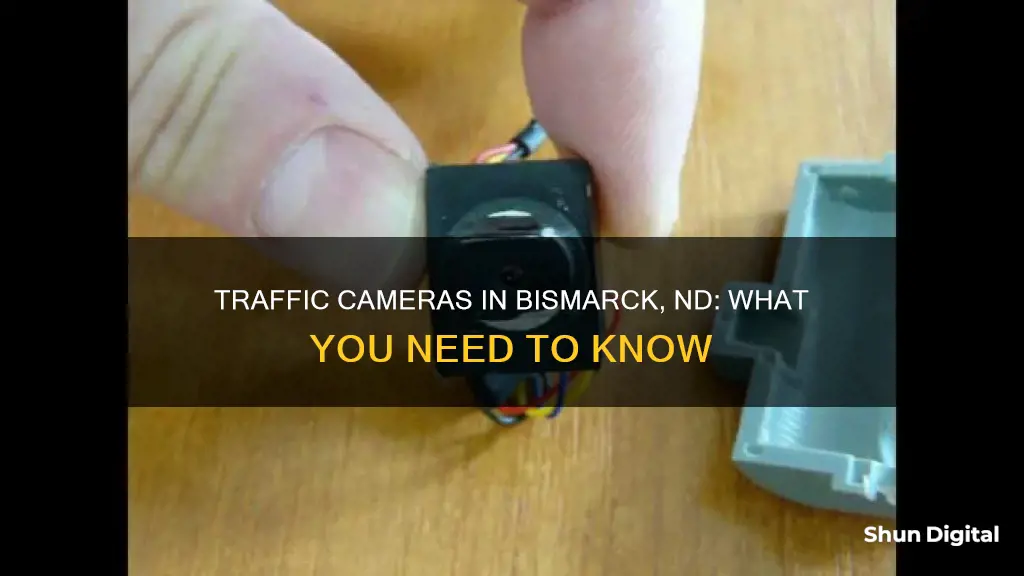
Yes, there are traffic cameras in Bismarck, North Dakota. These cameras are in place to monitor traffic flow and vehicle detection at signals, and are not used for constant surveillance or law enforcement. The cameras do not record or store any images, and are unable to identify license plates or facial features.
| Characteristics | Values |
|---|---|
| Purpose | Detecting vehicles to provide the best distribution of green time based on traffic demand |
| Surveillance | No constant surveillance or archiving of images |
| Recording | No recording |
| Image Analysis | Real-time analysis by the processor, with no storage of the image stream |
| Camera View | Fixed focus and fixed location, with no zooming or moving capabilities once installed |
| Image Resolution | Not high enough to read license plates or distinguish facial features |
| Law Enforcement | Not tied to any law enforcement system |
| Cost-Effectiveness | More cost-effective than in-ground induction loops for vehicle detection; lower long-term costs |
What You'll Learn
- Traffic cameras in Bismarck, ND, are solely for traffic signal operations
- They are cost-effective replacements for in-ground induction loops
- Cameras are not focused on the driver but on the vehicle
- There is no constant surveillance, recording, or archiving of images
- The resolution is not good enough to read license plates or distinguish facial features

Traffic cameras in Bismarck, ND, are solely for traffic signal operations
There are traffic cameras in Bismarck, North Dakota. These cameras are placed at various locations, including interstate highways, intersections, and rest areas. For example, there are cameras on I-94 at the Grant Marsh Bridge and Apple Creek Rest Area, as well as on ND-200 and Perimeter Road.
The presence of these traffic cameras in Bismarck, ND, serves a specific purpose: to aid in traffic signal operations. These cameras are strategically positioned to detect vehicles and optimize the distribution of green lights according to traffic demand. By capturing the movement of vehicles towards intersections, the cameras send output to the traffic signal controller, enhancing the efficiency of traffic flow.
It is important to note that these traffic cameras are not focused on the drivers themselves but rather on the vehicles as they approach and enter intersections. The cameras do not record or archive any images, and there is no constant surveillance. The video feed is processed in real-time, and the images are not stored. The resolution of the images captured by these cameras is also insufficient to identify license plates or facial features.
The primary objective of these traffic cameras is to improve traffic management by providing a cost-effective solution. They offer a more efficient and economical alternative to in-ground induction loops, which require cutting into the pavement and installing wire loops. The use of cameras eliminates the need for disruptive and costly pavement work while still achieving the desired results of efficient traffic signal operations.
In summary, the traffic cameras in Bismarck, ND, are solely for traffic signal operations. They play a crucial role in detecting vehicles, optimizing green light distribution, and ultimately improving the flow of traffic in the area. These cameras are designed with specific limitations to protect the privacy of individuals and are not tied to any law enforcement systems.
The Evolution of Camera Bellows: Materials and Design
You may want to see also

They are cost-effective replacements for in-ground induction loops
Traffic cameras are present in Bismarck, North Dakota. They are located at the following places:
- E Divide Ave @ North Dakota Capitol Building
- I-94 @ Grant Marsh Bridge
- I-94 WB @ Apple Creek Rest Area
- I-94 WB @ Hailstone Rest Area
- 72nd St w/o New Leipzig
- ND-200 e/o Golden Valley
- Perimeter Rd s/o White Shield
- I-94 w/o Green River
- I-94 EB w/o Jamestown
- I-94 WB w/o Jamestown
- I-94 EB e/o Jamestown
Now, here is some information on why they are cost-effective replacements for in-ground induction loops:
In-ground induction loops, also known as inductive-loop traffic detectors, have been widely used for traffic management since the early 1960s. They work by installing insulated, electrically conducting loops in the pavement. When a vehicle passes over or stops within the loop, it induces eddy currents in the wire loops, leading to a decrease in their inductance. This change in inductance triggers a response in the electronics unit, which then sends a signal to the traffic controller.
While induction loops have been a popular choice for vehicle detection, they do have some limitations. One of the main drawbacks is their high installation and maintenance costs. Installing induction loops requires cutting into the pavement, which can be disruptive and expensive. Additionally, the loops themselves can be susceptible to damage from weather conditions and heavy vehicles, leading to frequent repairs.
In recent years, traffic cameras have emerged as a cost-effective replacement for in-ground induction loops. Here are some reasons why traffic cameras are a more economical option:
- Ease of Installation and Maintenance: Traffic cameras can be installed on existing structures like poles or buildings, eliminating the need for disruptive roadworks. This not only makes the installation process faster and more convenient but also significantly reduces the initial setup costs. Moreover, modern traffic cameras are designed to be low-maintenance, with long-lasting components and remote monitoring capabilities, further reducing ongoing expenses.
- Versatility and Flexibility: Cameras offer a more versatile solution for traffic monitoring. They can be placed at various locations and heights, providing a bird's-eye view of the traffic situation. This flexibility allows transportation authorities to optimize camera placement for maximum coverage and efficiency. Additionally, cameras can be easily repositioned or relocated to adapt to changing traffic patterns or temporary road layouts during construction or special events.
- Advanced Technology: Modern traffic cameras are equipped with advanced technologies such as artificial intelligence and machine learning algorithms. These technologies enable cameras to accurately detect and classify vehicles, track traffic flow, and even identify license plates. This level of sophistication goes beyond the capabilities of traditional induction loops, providing more detailed and actionable data for traffic management.
- Enhanced Data Analysis: Traffic cameras, combined with intelligent transportation systems, offer a wealth of data analytics possibilities. The video footage captured by cameras can be analyzed to study traffic patterns, identify congestion hotspots, and optimize signal timings. This data-driven approach to traffic management can lead to more efficient road networks and improved driver experiences.
- Multipurpose Functionality: Traffic cameras can serve multiple purposes beyond vehicle detection. They can be used for traffic enforcement, such as monitoring speed, capturing red-light violations, or detecting vehicles that run stop signs. Additionally, cameras can enhance road safety by providing real-time monitoring of accident-prone areas or hazardous road conditions. In some cases, cameras can also be integrated with other smart city solutions, further extending their functionality.
- Scalability and Expandability: Camera-based systems offer a scalable solution for traffic management. It is relatively easy to add more cameras to the network as the needs of a city grow. Furthermore, the data from these cameras can be integrated with central command centers, enabling a comprehensive view of the entire transportation network. This scalability and expandability make camera systems a more future-proof investment compared to induction loops.
By leveraging the latest advancements in camera technology and data analytics, transportation authorities can improve traffic management while also reducing costs. The initial investment in a camera system can lead to long-term savings by eliminating the need for frequent repairs and providing a more adaptable solution for the dynamic nature of urban transportation. Therefore, traffic cameras present a compelling and cost-effective alternative to in-ground induction loops.
Do Dash Cameras Drain Car Batteries?
You may want to see also

Cameras are not focused on the driver but on the vehicle
There are traffic cameras in Bismarck, North Dakota. These cameras are placed at various locations, including:
- I-94 WB @ Apple Creek Rest Area
- I-94 EB e/o Jamestown
- Bismarck/Mandan I-94 W (MP: 119.400) Hailstone Rest Area - West
- Bismarck/Mandan I-94 E (MP: 154.059) Mandan@Mandan Ave - West
- E Divide Ave @ North Dakota Capitol Building
It is important to note that these cameras are not focused on the driver but on the vehicle. The purpose of these video detection cameras is to detect the presence of vehicles to provide the best distribution of green time based on traffic demand. They are positioned to capture the movement of vehicles towards intersections and are not used for constant surveillance or recording.
The cameras have a fixed focus and fixed location, and their images are not stored or archived. The resolution is also insufficient to identify license plates or facial features. These cameras are solely for traffic management and are not tied to any law enforcement system. They offer a cost-effective solution, replacing the need for in-ground induction loops that require cutting into the pavement.
The use of these cameras allows for efficient traffic signal operations without disrupting the pavement or causing traffic flow issues during installation or maintenance. They are an effective use of taxpayer money, providing a balance between cost and functionality.
Battery Saver Mode: Impact on Camera Performance
You may want to see also

There is no constant surveillance, recording, or archiving of images
There are traffic cameras in Bismarck, North Dakota. These cameras are placed at various intersections and locations to monitor traffic flow and aid in efficient traffic signal operations. However, it is important to emphasize that these cameras are not tools for constant surveillance or personal monitoring.
The traffic cameras in Bismarck, ND, are specifically designed for video detection purposes. This means that they are programmed to detect the presence of vehicles within their field of view. By focusing on the vehicle as it moves towards an intersection, the cameras help optimize the distribution of green time at traffic signals based on real-time traffic demand. This technology is a cost-effective replacement for in-ground induction loops, enhancing the efficiency of traffic management without the need for pavement disruptions.
It is essential to understand the limitations of these traffic cameras. There is no constant surveillance, recording, or archiving of images. The cameras are not capable of capturing identifiable details, such as license plates or facial features. The resolution is intentionally limited to ensure privacy and focus on the sole task of vehicle detection. The images are analyzed in real-time by a processor, and there is no storage or archiving of the image stream.
The primary purpose of these cameras is to improve traffic flow and signal operations. They are not tied to any law enforcement systems or used for any form of monitoring beyond vehicle detection. The camera view is fixed, and there is no capability to zoom or move the cameras once they are installed. This fixed focus and fixed location further emphasize the sole purpose of vehicle presence detection without infringing on privacy or conducting constant surveillance.
In summary, while there are traffic cameras in Bismarck, ND, they are not a means for constant surveillance or recording. These cameras are a vital tool for efficient traffic management, focusing solely on vehicle detection to optimize traffic signal operations. The limitations in resolution, lack of recording, and fixed nature of the cameras ensure that they serve their intended purpose without infringing on the privacy or constant monitoring of individuals.
The Sweet Journey: Chocolate's On-Camera Making
You may want to see also

The resolution is not good enough to read license plates or distinguish facial features
There are traffic cameras in Bismarck, North Dakota. These cameras are placed at various locations, including:
- I-94 WB @ Apple Creek Rest Area
- I-94 EB e/o Jamestown
- Bismarck/Mandan I-94 W (MP: 119.400) Hailstone Rest Area - West
- Bismarck/Mandan I-94 E (MP: 154.059) Mandan@Mandan Ave - West
- E Divide Ave @ North Dakota Capitol Building
- 72nd St w/o New Leipzig
The traffic cameras in Bismarck, ND, are not for constant surveillance or archiving. They are video detection cameras that detect the presence of vehicles to optimize traffic signal operations. The resolution of the images captured by these cameras is not high enough to read license plates or identify facial features.
The cameras have a fixed focus and are installed in fixed locations. They do not have the capability to zoom or move once they are set up. The images are processed in real-time to detect vehicles within defined areas or "zones" in the camera's field of view. This information is then used to manage the distribution of green time at traffic signals based on traffic demand.
The primary purpose of these cameras is to improve traffic flow and signal timing, and they are not tied to any law enforcement systems. They offer a cost-effective solution, as the previous method of vehicle detection involved cutting into the pavement and installing wire loops, which was labour-intensive and had long-term maintenance costs.
Dual Car Cameras: Enhanced Vision and Safety
You may want to see also
Frequently asked questions
Yes, there are traffic cameras in Bismarck, North Dakota.
The traffic cameras in Bismarck, ND, are used for vehicle detection to provide the best distribution of green time based on traffic demand.
The traffic cameras in Bismarck, ND, are located at major intersections and on highways such as I-94 and US 83.







